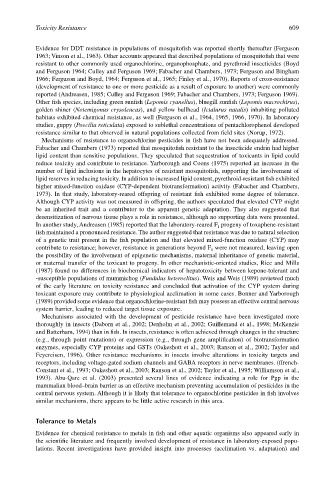Page 629 - The Toxicology of Fishes
P. 629
Toxicity Resistance 609
Evidence for DDT resistance in populations of mosquitofish was reported shortly thereafter (Ferguson
1963; Vinson et al., 1963). Other accounts appeared that described populations of mosquitofish that were
resistant to other commonly used organochlorine, organophosphate, and pyrethroid insecticides (Boyd
and Ferguson 1964; Culley and Ferguson 1969; Fabacher and Chambers, 1973; Ferguson and Bingham
1966; Ferguson and Boyd, 1964; Ferguson et al., 1965; Finley et al., 1970). Reports of cross-resistance
(development of resistance to one or more pesticide as a result of exposure to another) were commonly
reported (Andreasen, 1985; Culley and Ferguson 1969; Fabacher and Chambers, 1973; Ferguson 1969).
Other fish species, including green sunfish (Lepomis cyanellus), bluegill sunfish (Lepomis macrochirus),
golden shiner (Notemigonus crysoleucas), and yellow bullhead (Ictalurus natalis) inhabiting polluted
habitats exhibited chemical resistance, as well (Ferguson et al., 1964, 1965, 1966, 1970). In laboratory
studies, guppy (Poecilia reticulata) exposed to sublethal concentrations of pentachlorophenol developed
resistance similar to that observed in natural populations collected from field sites (Norup, 1972).
Mechanisms of resistance to organochlorine pesticides in fish have not been adequately addressed.
Fabacher and Chambers (1973) reported that mosquitofish resistant to the insecticide endrin had higher
lipid content than sensitive populations. They speculated that sequestration of toxicants in lipid could
reduce toxicity and contribute to resistance. Yarborough and Coons (1975) reported an increase in the
number of lipid inclusions in the hepatocytes of resistant mosquitofish, supporting the involvement of
lipid reserves in reducing toxicity. In addition to increased lipid content, pyrethroid-resistant fish exhibited
higher mixed-function oxidase (CYP-dependent biotransformation) activity (Fabacher and Chambers,
1973). In that study, laboratory-reared offspring of resistant fish exhibited some degree of tolerance.
Although CYP activity was not measured in offspring, the authors speculated that elevated CYP might
be an inherited trait and a contributor to the apparent genetic adaptation. They also suggested that
desensitization of nervous tissue plays a role in resistance, although no supporting data were presented.
In another study, Andreasen (1985) reported that the laboratory-reared F progeny of toxaphene-resistant
1
fish maintained a pronounced resistance. The author suggested that resistance was due to natural selection
of a genetic trait present in the fish population and that elevated mixed-function oxidase (CYP) may
contribute to resistance; however, resistance in generations beyond F were not measured, leaving open
1
the possibility of the involvement of epigenetic mechanisms, maternal inheritance of genetic material,
or maternal transfer of the toxicant to progeny. In other mechanistic-oriented studies, Rice and Mills
(1987) found no differences in biochemical indicators of hepatotoxicity between kepone-tolerant and
-susceptible populations of mummichog (Fundulus heteroclitus). Weis and Weis (1989) reviewed much
of the early literature on toxicity resistance and concluded that activation of the CYP system during
toxicant exposure may contribute to physiological acclimation in some cases. Bonner and Yarborough
(1989) provided some evidence that organochlorine-resistant fish may possess an effective central nervous
system barrier, leading to reduced target tissue exposure.
Mechanisms associated with the development of pesticide resistance have been investigated more
thoroughly in insects (Daborn et al., 2002; Denholm et al., 2002; Guillemand et al., 1998; McKenzie
and Batterham, 1994) than in fish. In insects, resistance is often achieved through changes in the structure
(e.g., through point mutations) or expression (e.g., through gene amplification) of biotransformation
enzymes, especially CYP proteins and GSTs (Oakeshott et al., 2003; Ranson et al., 2002; Taylor and
Feyereisen, 1996). Other resistance mechanisms in insects involve alterations in toxicity targets and
receptors, including voltage-gated sodium channels and GABA receptors in nerve membranes. (ffrench-
Constant et al., 1993; Oakeshott et al., 2003; Ranson et al., 2002; Taylor et al., 1995; Williamson et al.,
1993). Abu-Qare et al. (2003) presented several lines of evidence indicating a role for Pgp in the
mammalian blood–brain barrier as an effective mechanism preventing accumulation of pesticides in the
central nervous system. Although it is likely that tolerance to organochlorine pesticides in fish involves
similar mechanisms, there appears to be little active research in this area.
Tolerance to Metals
Evidence for chemical resistance to metals in fish and other aquatic organisms also appeared early in
the scientific literature and frequently involved development of resistance in laboratory-exposed popu-
lations. Recent investigations have provided insight into processes (acclimation vs. adaptation) and

